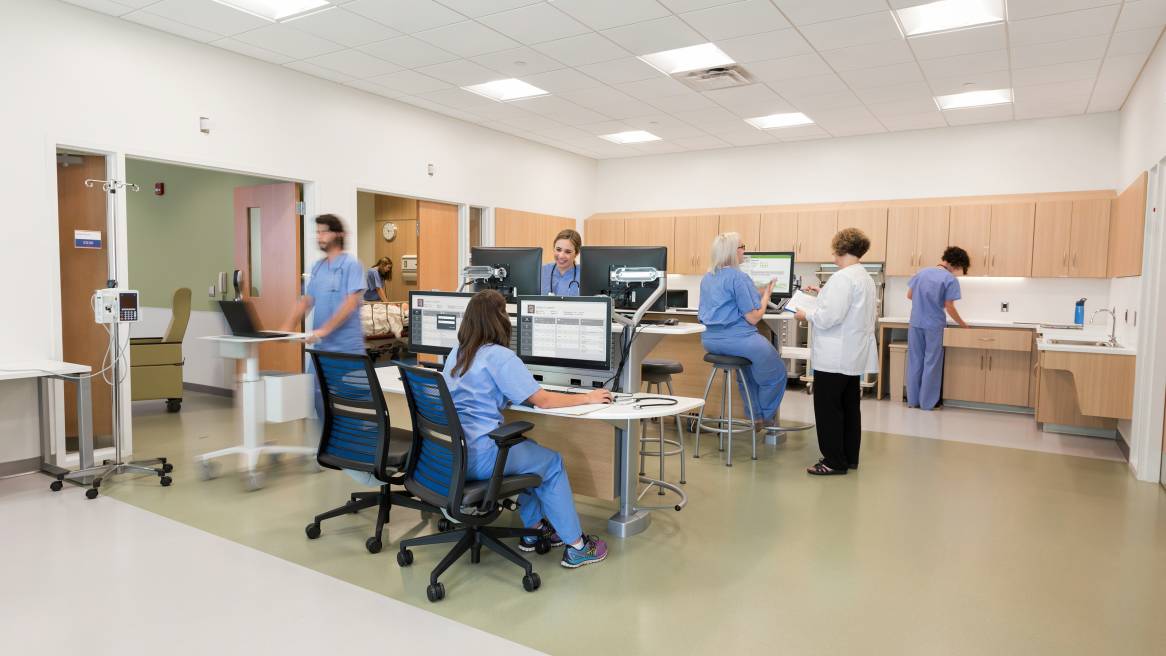Pennsylvania College of Health Sciences
Health sciences educators face a continual challenge: how to provide students all the clinical training they need.
Campus Nexus: Pennsylvania College of Health Sciences Unites Education and Healthcare Environments
Health sciences educators face a continual challenge: how to provide students all the clinical training they need. Nursing students, for example, learn the science of nursing mostly in the classroom, but develop practical skills at the bedside, in hospitals and clinics.
Meanwhile, clinical placements for students are getting harder to find as the demand for healthcare professionals increases —driving the need for even more clinical placements.
So, where will students get this critical training?
In unique learning environments that combine the elements of both healthcare and education spaces, such as the Center for Excellence in Practice, at the Pennsylvania College of Health Sciences (PA College), Lancaster, PA.
The Center is a 20,000 square-foot immersive learning space that replicates a real world treatment facility. It includes 24 patient rooms and 40 beds, a home care suite, simulation hospital, radiology suite, operating room and other hospital spaces where students can learn essential clinical skills.
Clinical experience in a classroom
Students here work closely with patients played by actors, or high tech mannequins that simulate various symptoms and conditions, and a team of clinical and simulation experts. This environment seamlessly integrates furniture and technology so students learn to provide connected care, a more collaborative and effective health experience for both patients and healthcare providers.
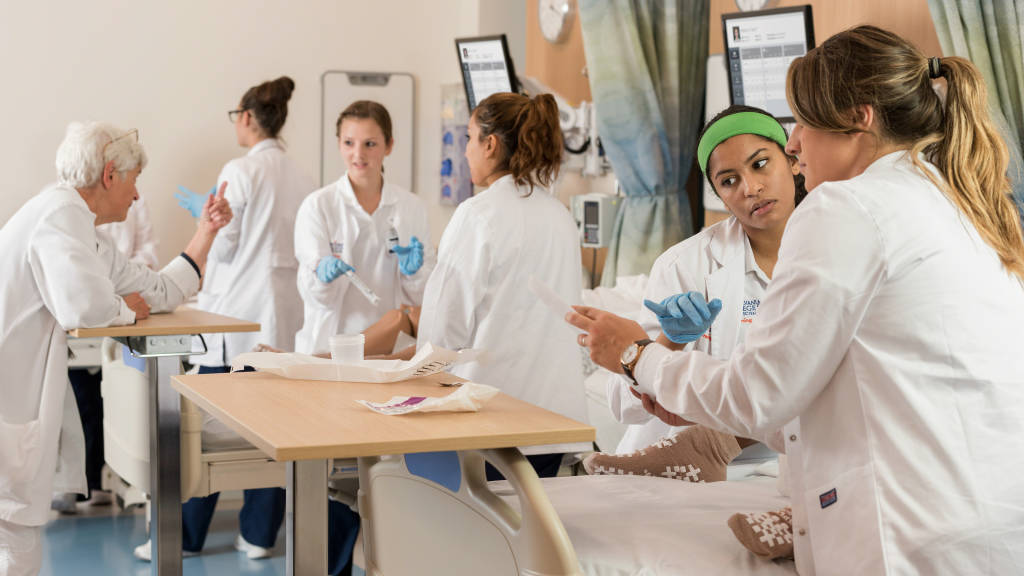
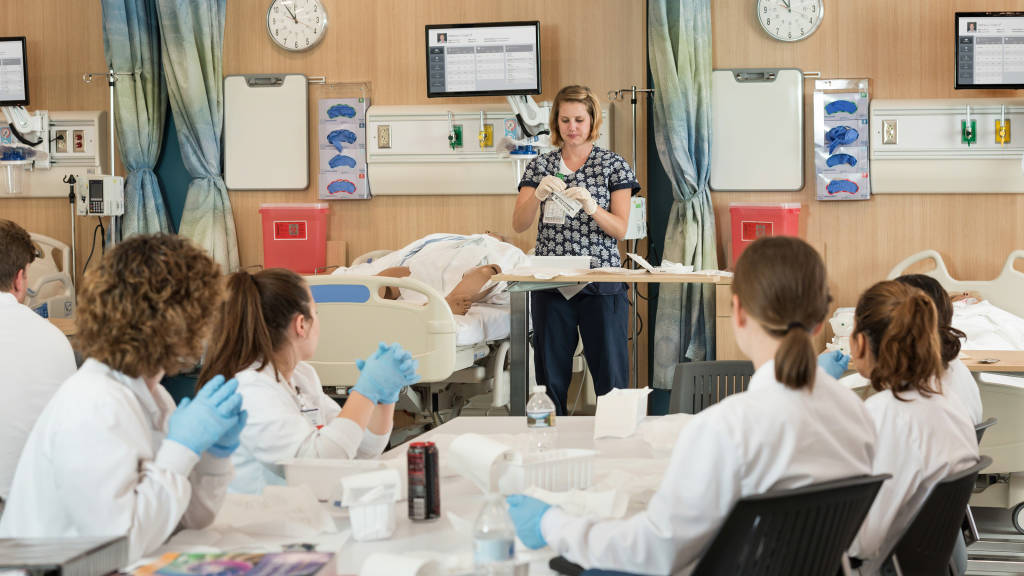
It’s an ideal place for educating healthcare professionals across various fields, says Joe Corvino, director of simulation and learning. “We can support the nursing program on Monday, the respiratory therapy program on Wednesday, and an in-service training for visiting radiology techs on Friday. The space and the furniture can adapt and change, not only from one day to the next, but over the next five or ten years as well.”
Measuring the value of simulation training
How effective is simulation training? A three-year study by the National Council of State Boards of Nursing with ten nursing schools across the United States , including PA College, showed that students who received up to 50 percent of clinical skills learning in a simulation lab performed equally as well in their jobs as those who received 90% of clinical skills learning in a hospital or clinic setting. The results, measured by grades, board exams and job performance, demonstrate that simulation training has an important role in clinical education.
Simulation learning offers unique benefits, too. “It allows you to set each scenario to specific learning objectives and plan the experience. The students can go through it and then go back over it as a team, review what happened and how they can do it better,” says Penni Longenecker, vice president of academic affairs.
“You often don’t have time to do that in a clinical setting, where you might have some debriefing. Here you can do it in more detail, and faculty can gauge what the student learned and better prepare the next simulation.”
Rare and unusual patient cases are easily presented, too, says Longenecker. “Students won’t get to work on those patients very often during clinical training, because they’re high risk. In the simulation lab, students can think through all the variables that go into that patient. They can work on them as an interdisciplinary team, which helps bridge the gap between professions.”
Another advantage of the Center for Excellence in Practice stems from seamlessly integrated furniture and equipment that helps focus learning. For example, the patient room headwalls were originally planned to be millwork mounted in the drywall. The school switched to Opus headwalls from Steelcase Health not only to ensure flexibility to change the space as needed, but also to provide functional and aesthetic consistency that supports the learning process. When students can concentrate on the skill they’re learning with less distraction from the environment, “they can transition quickly from a learning moment to a performing moment. It helps them learn to perform, to hone their skills and become competent and confident,” says Corvino.
“Simulation allows you to set each scenario to specific learning objectives and plan the experience.”
Penni Longeneckervice president of academic affairs
The power of shared learning
A significant portion of clinical skills learning, according to both the National Council study and experienced educators, develops after skills practice, in discussions between peers and faculty. That’s why there are five debrief rooms in the Center, as well as many other collaboration spaces across campus.
“Every space on this campus is a learning space. It’s a concept we have embraced for some time,” says Mary Grace Simcox, PA College president and a longtime nurse and nursing educator. “I met Steelcase consultants at a conference years ago, and they had a forward-thinking perspective on how every space on campus can support learning. We never lost sight of that.
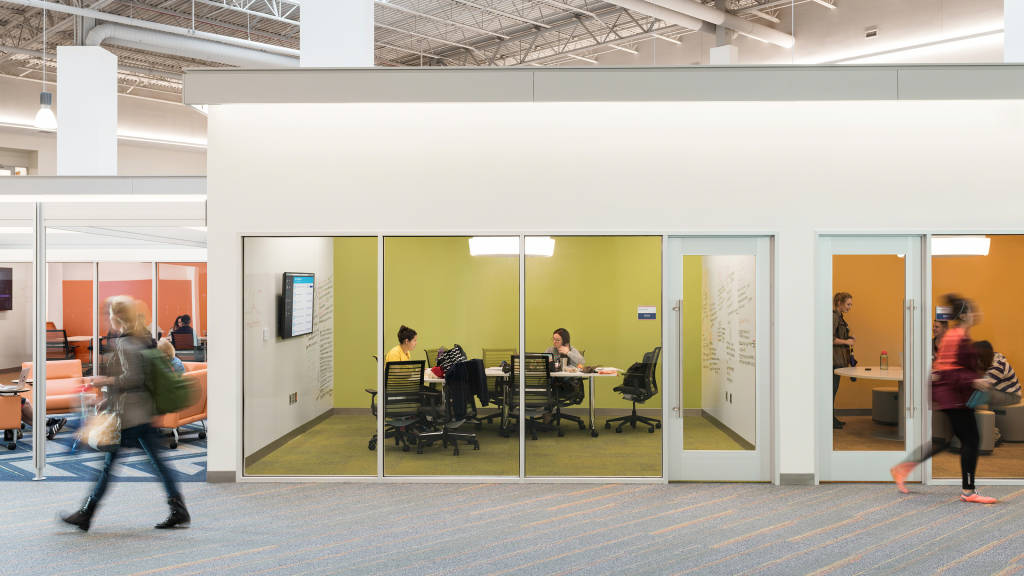
“I even try not to use the word ‘classroom’ because it connotes four walls that you have to be inside a box to learn. We have a campus that’s open, with so many collaboration spaces, everything wired to the hilt. You don’t have to be in a room to learn. Wherever the student and faculty are, that’s where they can learn.”
Campus spaces are shared, not owned, by departments. Settings are flexible so they can support practically any subject or pedagogy. Enclosed spaces, such as group study rooms, have glass walls “so you’re visually connected with the rest of the space. Students can see others learning and be seen learning,” says Deborah Knast, associate at Stantec Architecture.
Collaboration requires movement, so “98 percent of what we put in our campus learning environments is on wheels— tables, chairs, pocket carts. Everything is mobile. In three to five minutes you can completely reconfigure a space to whatever your heart desires for that day,” says facilities director Scott Lokey.
LearnLab environments integrate media:scape collaboration technology around a worksurface, with mobile seating, whiteboards and three different projection screens at precisely triangulated locations. Combined with a unique “X” room configuration, LearnLabs offer every student clear sight lines, so digital and analog content can be shared from any location in the room.
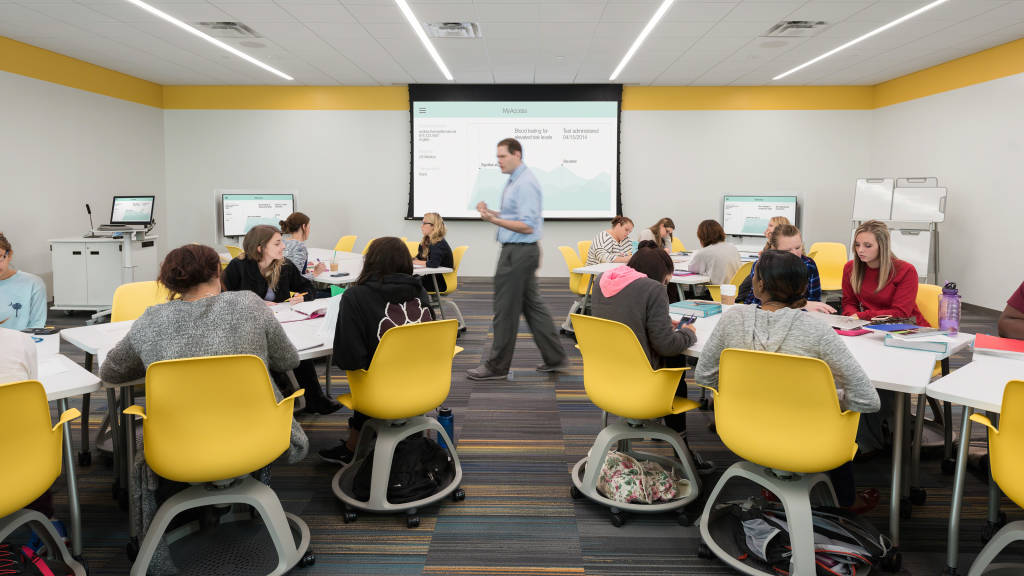
“These spaces fit right into our key strategy of being a learner-centered curriculum and culture,” says Corvino. “They make it easy for each student to share their information and experience with others.”
A “commuter school” no longer
In 2002 the school transitioned from a diploma nursing school to a degree-granting institution and expanded to offer other health-related degrees. Enrollment grew by double digits each year over the next decade, yet PA College still was known as a “commuter school.”
The campus itself, with five old buildings, some as much as two miles apart, was the problem. Students had to park offsite and ride a shuttle three miles to get to class. With no cafeteria or common space where students could gather and socialize and few places for individual or group study, students practically fled the campus after class.
The new campus changes everything. Two buildings (former industrial facilities, gutted and rebuilt) are linked by a glass corridor: one houses admissions, counseling, staff offices, dining facilities and more, while the other has 28 classrooms, an auditorium, labs, and the Center for Excellence in Practice.
Befitting a college for healthcare students, PA College also fosters a sense of wellbeing with a fitness and wellness center, a rejuvenation center offering places for quiet reflection and relaxation and a medical suite with on-site medical staff.
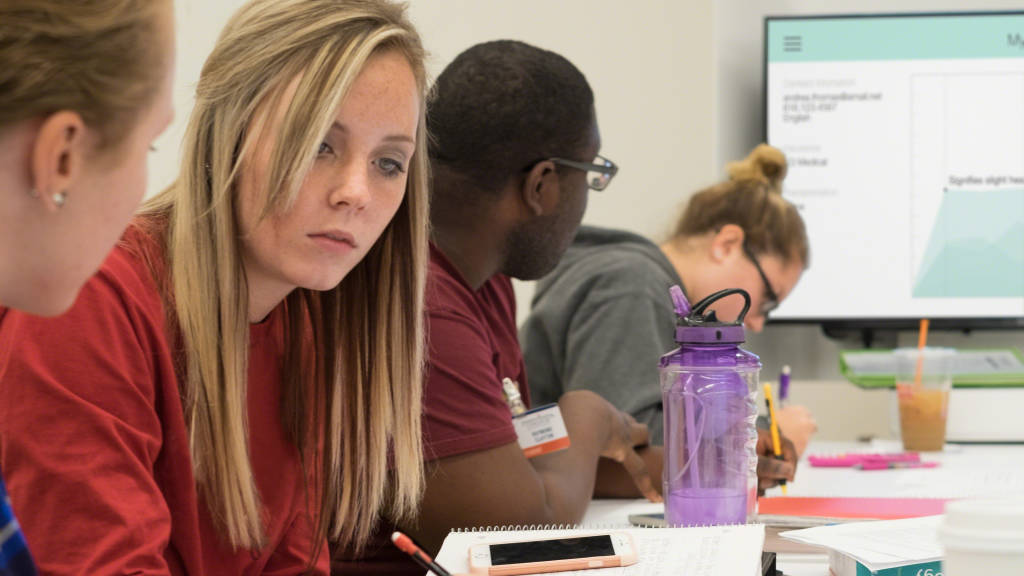
The campus feels both open and connected. “The old way of teaching in a closed space, with students in rows, sitting through a lecture— that’s a very isolated way of learning. When every space is a learning space, there’s more transparency. You can build on each other’s energy,” says Longenecker.
Scott Lokey enjoys the enthusiasm of student as he shows them the new campus. “I was touring a group of students and one, a returning student, stopped me. “She said, ‘There used to be no reason to stay here after class. There were no places to study or get food. Now, I may finally make a friend here.'”
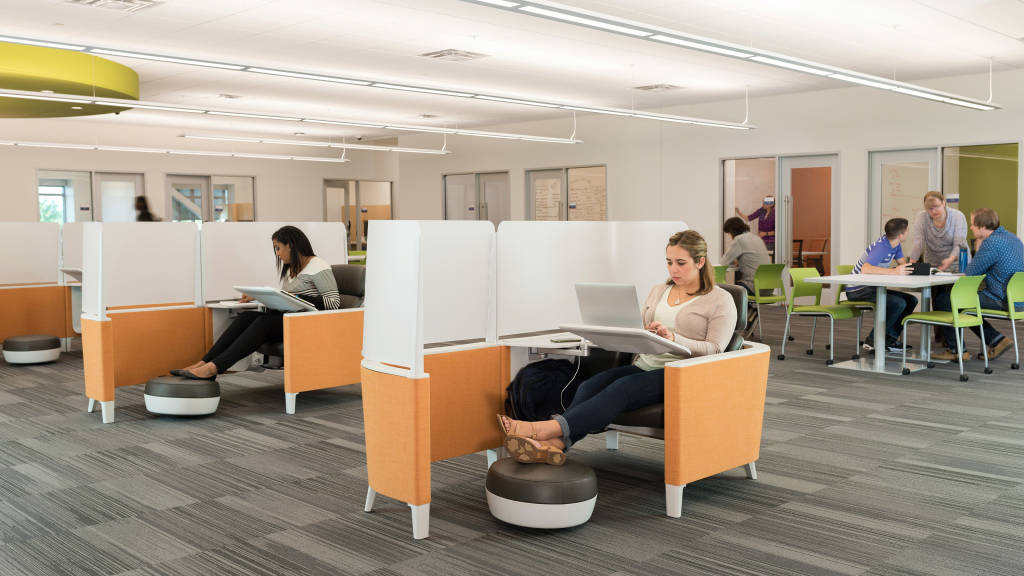
Integrating education and healthcare spaces
“Students see the opportunities that were not available here before, says President Simcox. “This changes how students learn, how they’re socialized, the relationships they can have. You can already sense a stronger sense of loyalty, a feeling of ‘I belong here.'”
Integrating education and healthcare spaces is key. “Throughout the design process, the Steelcase team listened, provided valuable input and expertise and developed high quality renderings and applications that aligned with the mission of the College,” says Corvino, director of simulation and learning.
Tom Hulstine, vice president of finance and administration, appreciates the partnership that made it all happen. “We didn’t have to run around to different companies for workspaces, common areas, classrooms, conference spaces. Steelcase rises quickly to the top of who is really doing the research and putting that research into practice in their furniture, in workspaces, in classrooms of the future.”
Credits
Architecture and Design: Stantec Architecture, Philadelphia
Dealership: Phillips Office Solutions
Steelcase Health Products
Opus casegoods and tables
Folio casegoods and tables
Sync clinician workstations
Overbed tables
Steelcase Education Products
Steelcase, Coalesse and Turnstone Products
media:scape collaboration settings
Brody WorkLounge
Answer systems furniture
Elective Elements systems furniture
Universal storage and worksurfaces
Await
Bindu
Bob
Buoy
Circa
Joel
Mitra
Move
Shortcut
Sidewalk
Think
Verge
Visalia
Campfire personal tables

